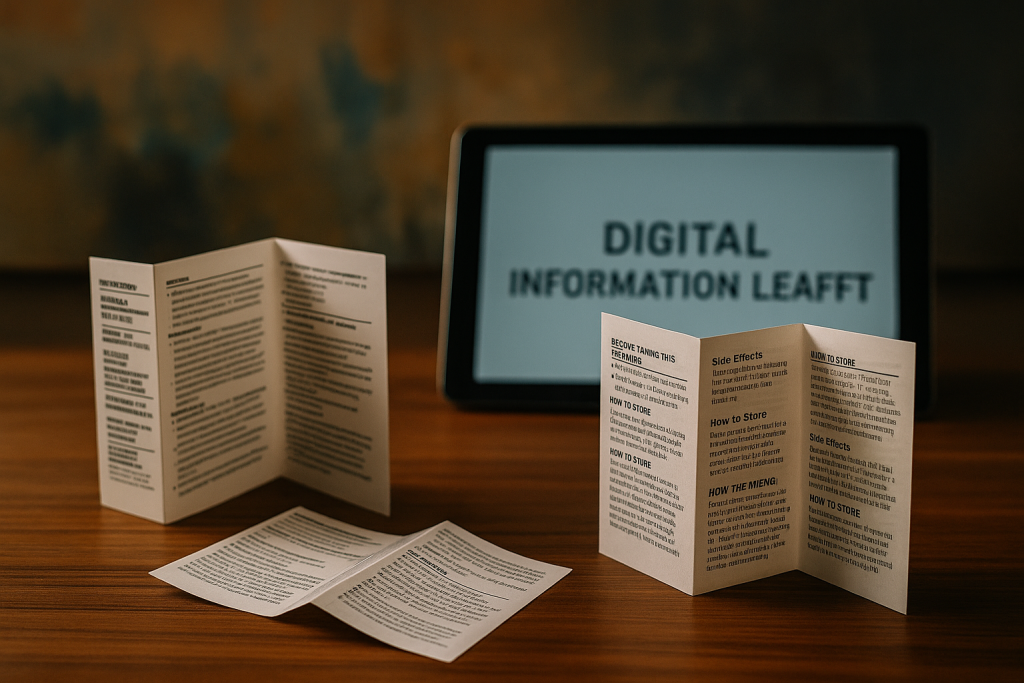
Enhancing Patient Safety: How Folded Inserts Outperform Digital Information Leaflets
In the healthcare sector, effective communication is crucial, especially when it comes to patient safety. Folded inserts have emerged as a vital tool for conveying important information to patients, offering distinct advantages over digital information leaflets. Miniature Folding Inc. specializes in providing high-quality folded leaflets that cater to the needs of pharmaceutical, healthcare, nutraceutical, and…
In the healthcare sector, effective communication is crucial, especially when it comes to patient safety. Folded inserts have emerged as a vital tool for conveying important information to patients, offering distinct advantages over digital information leaflets. Miniature Folding Inc. specializes in providing high-quality folded leaflets that cater to the needs of pharmaceutical, healthcare, nutraceutical, and cosmetic industries. Let’s delve into how folded inserts enhance patient safety and why they are often preferred over digital formats.
The Importance of Patient Communication
Effective communication in healthcare is essential for ensuring that patients understand their treatment plans, medication instructions, and potential side effects. With the increasing complexity of healthcare information, the method of delivery can significantly impact patient comprehension and adherence. Folded inserts provide tangible, easy-to-read information, making them a critical resource in patient education.
Advantages of Folded Inserts
- Accessibility of Information
- Folded leaflets are readily accessible to patients at all times. Unlike digital leaflets that require a device and internet access, printed leaflets can be physically handed to patients, allowing them to review the information at their convenience.
- Enhanced Readability
- Printed materials can be designed for optimal readability, using appropriate fonts, sizes, and layouts that cater to diverse patient populations, including those with visual impairments. Folded inserts can incorporate clear headings, bullet points, and illustrations to enhance understanding.
- Retention of Information
- Studies have shown that patients are more likely to retain information presented in printed form compared to digital formats. The tactile experience of handling physical materials can improve memory recall, making it easier for patients to remember important instructions.
- No Technology Barriers
- Not all patients are tech-savvy or have access to electronic devices. Folded leaflets eliminate barriers related to technology literacy, ensuring that all patients, regardless of age or technical proficiency, can access important information.
- Immediate Reference
- Folded inserts provide patients with a quick reference guide. They can be kept with medications or in a prominent place at home, allowing patients to refer back to essential information without needing to search through digital files or websites.
- Customization for Specific Needs
- Folded leaflets can be tailored to meet specific patient needs or conditions. For example, a pharmaceutical company can create leaflets that target particular demographics or health issues, ensuring that the content is relevant and useful to the patient.
- Reduced Risk of Information Overload
- Digital platforms can overwhelm patients with excessive information. Folded inserts can present critical information in a concise manner, breaking down complex topics into digestible sections that are easier for patients to understand.
- Avoiding Digital Distractions
- In a world filled with digital distractions, printed materials provide a focused way for patients to absorb information without the interruptions commonly associated with smartphones, tablets, or computers.
The Role of Folded Inserts in Patient Safety
- Clear Medication Instructions
- Folded leaflets can provide step-by-step instructions on medication usage, including dosages, timing, and potential side effects. This clarity helps prevent medication errors and enhances adherence to treatment plans.
- Emergency Information
- In case of adverse reactions or emergencies, folded inserts can include crucial information on what to do and who to contact, ensuring that patients have immediate guidance at hand.
- Visual Aids
- Incorporating diagrams or images within folded inserts can help explain complex medical procedures or instructions. Visual aids facilitate better understanding, especially for patients who may struggle with text-heavy information.
- Patient-Centric Design
- By understanding the specific needs of patients, folded leaflets can be designed to prioritize the most critical information, ensuring that patients receive what they need to know without unnecessary details that could lead to confusion.
- Compliance with Regulations
- Folded inserts often meet regulatory requirements for patient information dissemination, ensuring that healthcare providers adhere to legal standards while providing necessary education to patients.
Digital Information Leaflets: Limitations
While digital information leaflets have their advantages, they also come with limitations that can hinder effective patient communication:
- Device Dependency
- Access to digital information relies on the availability of electronic devices and internet connectivity, which may not be feasible for all patients.
- Screen Fatigue
- Patients may experience screen fatigue, particularly older individuals or those not accustomed to prolonged screen time, leading to reduced engagement with digital content.
- Information Overload
- Digital platforms can present an overwhelming amount of information, making it challenging for patients to locate pertinent details quickly.
- Technical Issues
- Technical glitches, slow internet connections, or compatibility issues can hinder access to vital information when patients need it most.
- Privacy Concerns
- Some patients may be hesitant to access health information online due to privacy concerns, preferring the security of printed materials that don’t require personal information to access.
Making the Right Choice: Folded Inserts vs. Digital Leaflets
When considering how to provide patient information effectively, healthcare providers must weigh the benefits of folded inserts against digital leaflets. Here are some considerations:
- Patient Demographics: Understand the patient population. Older adults or those with limited tech access may benefit more from printed materials, while tech-savvy younger patients may prefer digital options.
- Type of Information: For critical medication instructions or safety information, printed folded inserts can provide clarity and assurance. In contrast, digital platforms may be better suited for supplementary information or updates.
- Cost and Resources: Evaluate the cost-effectiveness of producing printed materials versus digital content. While digital leaflets may seem cheaper in the long run, consider the potential impact on patient safety and engagement.
- Integration Strategies: Consider a hybrid approach that incorporates both folded leaflets and digital information. This way, patients can have access to printed materials while also being directed to online resources for further information.

The Role of Miniature Folding Inc. in Patient Safety
At Miniature Folding Inc., we are committed to providing high-quality folded inserts that enhance patient safety and understanding. Our expertise in folding and bindery services ensures that your materials are not only visually appealing but also functional and user-friendly.
With a focus on the pharmaceutical, healthcare, nutraceutical, and cosmetic industries, we understand the unique needs of each sector and tailor our solutions accordingly. Our team collaborates closely with clients to develop customized folding layouts and designs that prioritize patient safety and communication effectiveness.
Ready to Enhance Patient Safety?
Are you prepared to improve your patient communication strategy with effective folded inserts? Contact Miniature Folding Inc. today to learn how our specialized packaging solutions can support your goals while ensuring patient safety and satisfaction.
Might interest you:
Related Insights
Keep Exploring Sustainable Packaging Trends
 Read more
Read moreWhat Makes a Folding Insert High Quality? Key Features to Look For
High Quality Folding Inserts In the competitive landscape of packaging, folding inserts or folding sheets
 Read more
Read moreThe Ultimate Showdown: How Barcode Scanning Tags Stack Up Against QR Codes for Product Tracking
In the rapidly evolving landscape of inventory management and product tracking, businesses are increasingly relying
 Read more
Read moreEnhancing Patient Safety: How Folded Inserts Outperform Digital Information Leaflets
In the healthcare sector, effective communication is crucial, especially when it comes to patient safety.

